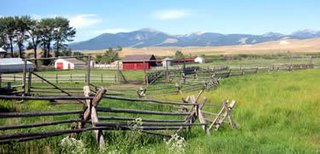
Rodeo is a competitive sport that arose out of the working practices of cattle herding in Spain, Mexico, and later Central America, South America, the United States, Canada, Australia and New Zealand. It was based on the skills required of the working vaqueros and later, cowboys, in what today is the western United States, western Canada, and northern Mexico. Today, it is a sporting event that involves horses and other livestock, designed to test the skill and speed of the cowboys and cowgirls. American style professional rodeos generally comprise the following events: tie-down roping, team roping, steer wrestling, saddle bronc riding, bareback bronc riding, bull riding and barrel racing. The events are divided into two basic categories: the rough stock events and the timed events. Depending on sanctioning organization and region, other events such as breakaway roping, goat tying, and pole bending may also be a part of some rodeos.

A cowboy is an animal herder who tends cattle on ranches in North America, traditionally on horseback, and often performs a multitude of other ranch-related tasks. The historic American cowboy of the late 19th century arose from the vaquero traditions of northern Mexico and became a figure of special significance and legend. A subtype, called a wrangler, specifically tends the horses used to work cattle. In addition to ranch work, some cowboys work for or participate in rodeos. Cowgirls, first defined as such in the late 19th century, had a less-well documented historical role, but in the modern world work at identical tasks and have obtained considerable respect for their achievements. Cattle handlers in many other parts of the world, particularly South America and Australia, perform work similar to the cowboy.
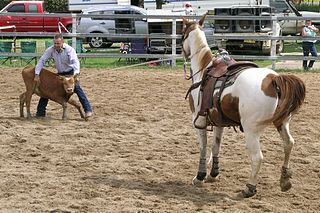
Calf roping, also known as tie-down roping, is a rodeo event that features a calf and a rider mounted on a horse. The goal of this timed event is for the rider to catch the calf by throwing a loop of rope from a lariat around its neck, dismount from the horse, run to the calf, and restrain it by tying three legs together, in as short a time as possible. A variant on the sport, with fewer animal welfare controversies, is breakaway roping, where the calf is roped, but not tied.

Barrel racing is a rodeo event in which a horse and rider attempt to complete a cloverleaf pattern around preset barrels in the fastest time. Though both boys and girls compete at the youth level, in collegiate and professional ranks, it is a rodeo event for women. It combines the horse's athletic ability and the horsemanship skills of a rider in order to safely and successfully maneuver a horse in a pattern around three barrels placed in a triangle in the center of an arena.
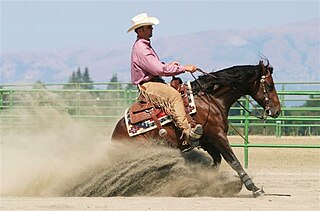
Reining is a western riding competition for horses where the riders guide the horses through a precise pattern of circles, spins, and stops. All work is done at the lope, or the gallop. Originating from working cattle, reining is often described as a Western form of dressage riding, as it requires the horse to be responsive and in tune with its rider, whose aids should not be easily seen, and judges the horse on its ability to perform a set pattern of movements. The horse should be willingly guided or controlled with little or no apparent resistance and dictated to completely. A horse that pins his ears, conveying a threat to his rider, refuses to go forward, runs sideways, bounces his rear, wrings his tail in irritation or displays an overall poor attitude is not being guided willingly, and is judged accordingly.

The National Finals Rodeo, organized by the Professional Rodeo Cowboys Association (PRCA), is the premier championship rodeo event in the United States. The NFR showcases the talents of the PRCA's top 15 money-winners in each event as they compete for the world title.

The Florida Cracker Horse is a breed of horse from Florida in the United States. It is genetically and physically similar to many other Spanish-style horses, especially those from the Spanish Colonial Horse group. The Florida Cracker is a gaited breed known for its agility and speed. The Spanish first brought horses to Florida with their expeditions in the early 16th century; as colonial settlement progressed, they used the horses for herding cattle. These horses developed into the Florida Cracker type seen today, and continued to be used by Florida cowboys until the 1930s.
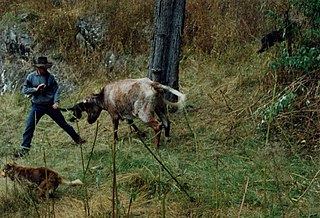
A muster (Au/NZ) or a roundup (US) is the process of gathering livestock. Musters usually involve cattle, sheep or horses, but may also include goats, camels, buffalo or other animals. Mustering may be conducted for a variety of reasons including routine livestock health checks and treatments, branding, shearing, lamb marking, sale, feeding and transport or droving to another location. Mustering is a long, difficult and sometimes dangerous job, especially on the vast Australian cattle stations of the Top End, 'The Falls' (gorge) country of the Great Dividing Range and the ranches of the western United States. The group of animals gathered in a muster is referred to as a "mob" in Australia and a "herd" in North America.
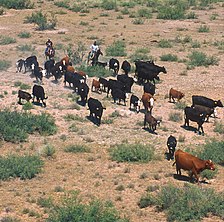
Cattle drives were a major economic activity in the 19th century American West, particularly between 1856 and 1896. In this period, 27 million cattle were driven from Texas to railheads in Kansas, for shipment to stockyards in Louisiana and points east. The long distances covered, the need for periodic rests by riders and animals, and the establishment of railheads led to the development of "cow towns" across the frontier.

Western riding is a style of horse riding which evolved from the ranching and warfare traditions brought to the Americas by the Spanish Conquistadors, and both equipment and riding style evolved to meet the working needs of the cowboy in the American West. American cowboys needed to work long hours in the saddle over rough terrain, sometimes needing to rope cattle with a lariat. Because of the necessity to control the horse with one hand and use a lariat with the other, western horses were trained to neck rein, that is, to change direction with light pressure of a rein against the horse's neck. Horses were also trained to exercise a certain degree of independence in using their natural instincts to follow the movements of a cow, thus a riding style developed that emphasized a deep, secure seat, and training methods encouraged a horse to be responsive on very light rein contact.

A cutting horse is a stock horse, typically a Quarter Horse, trained for the purpose of separating a single cow from a herd of cattle, and preventing it from getting back to the herd. One of the desired qualities in a cutting horse is cow sense or an innate ability to read a cow, eye to eye, attentively with ears forward in wary anticipation of each move.
The Canadian Cutting Horse Association (CCHA) is a non-profit organization dedicated to promoting the equestrian sport of cutting in Canada. Founded in 1954, it regulates a sport that began in the mid-1880s and became popular in Canada in the 1940s and 1950s. The CCHA maintains a Hall of Fame to honour members who have made outstanding contributions to the sport. The CCHA's patron is HRH Prince Philip, Duke of Edinburgh. Cutting is a sport based on ranchwork that began in the early 19th century, cutting cattle out of herds. Horses and riders are judged on how well they work to remove a single steer from a herd and keep it from returning. The CCHA promotes a type of horse called the Canadian cutting horse; this type is made up of many breeds with a common stock horse background.

A stock horse is a horse of a type that is well suited for working with livestock, particularly cattle. The related cow pony or cow horse is a historic phrase, still used colloquially today, referring to a particularly small agile cattle-herding horse; the term dates to 1874. The word "pony" in this context has little to do with the animal's size. though the traditional cow pony could be as small as 700 to 900 pounds and less than 14 hands high.
A remuda is a herd of horses from which ranch hands select their mounts. The word is of Spanish derivation, for 'remount' i.e. "change of horses" and is commonly used in the American West.
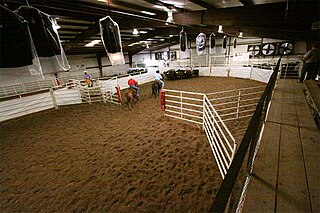
Ranch sorting is a western-style equestrian sport that evolved from the common ranch work of separating cattle into pens for branding, doctoring, or transport. Ranch Sorting is an event that pits a team of two riders on horseback against the clock. Teamwork is the key with both riders working in harmony to cut out the correct cattle and drive them to the pen while keeping the wrong numbered cattle back. There are several variations of ranch sorting with one, two or three riders on the team, but all require sorting the cattle from one pen to the other in the correct order.
A ranch rodeo is a traditional type of rodeo in which teams of cowboys or cowgirls from different ranches compete against each other in events based on the type of work they do every day.


